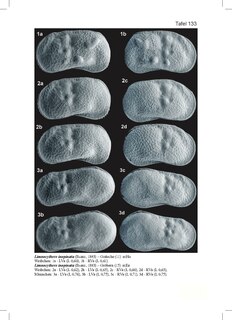
Laguna Lejía is a salt lake located in the Altiplano of the Antofagasta Region of northern Chile. The landscape of the area is dominated by the volcanoes Chiliques, Lascar, Aguas Calientes and Acamarachi. It is shallow and has no outlet, covering a surface area of about 1.9 square kilometres (0.73 sq mi) in the present-day.

Harper Lake is a dry lake located in the Mojave Desert near the small community of Lockhart, California, in northwestern San Bernardino County of Southern California. The lake is accessible from Harper Lake Road, which runs north off of State Route 58 midway between Boron and Barstow.
Limnocythere porphyretica is a species of crustacean in family Limnocytheridae. It is endemic to Australia.
Limnocythere is a genus of ostracod crustaceans in the family Limnocytheridae. It contains the following extant species :

Lake Manix is a former lake fed by the Mojave River in the Mojave Desert. It lies within San Bernardino County, California. Located close to Barstow, this lake had the shape of a cloverleaf and covered four basins named Coyote, Cady/Manix, Troy and Afton. It covered a surface area of 236 square kilometres (91 sq mi) and reached an altitude of 543 metres (1,781 ft) at highstands, although poorly recognizable shorelines have been found at altitudes of 547–558 metres (1,795–1,831 ft). The lake was fed by increased runoff during the Pleistocene and overflowed into the Lake Mojave basin and from there to Lake Manly in Death Valley, or less likely into the Bristol Lake basin and from there to the Colorado River.
In August 2018, the IUCN Red List of Threatened Species identified 6086 Vulnerable species, subspecies and varieties, stocks and sub-populations in the Animalia kingdom.
Limnocytheridae is a family of ostracods, containing the following genera:

Lake Cahuilla was a prehistoric lake in California and northern Mexico. Located in the Coachella and Imperial Valleys, it covered surface areas of 5,700 square kilometres (2,200 sq mi) to a height of 12 metres (39 ft) above sea level during the Holocene. During earlier stages of the Pleistocene, the lake reached even higher levels, up to 31–52 metres (102–171 ft) above sea level. During the Holocene most of the water came from the Colorado River with little contribution from local runoff; in the Pleistocene local runoff was higher and it is possible that Lake Cahuilla was supported solely from local water sources during the Wisconsin glaciation. The lake overflowed close to Cerro Prieto into the Rio Hardy, eventually draining into the Gulf of California.

Lake Manly was a pluvial lake in Death Valley, California, covering much of Death Valley with a surface area of 1,600 square kilometres (620 sq mi) during the so-called "Blackwelder stand". Water levels varied through its history, and the chronology is further complicated by active tectonic processes that have modified the elevations of the various shorelines of Lake Manly; during the Blackwelder stage they reached 47–90 metres (154–295 ft) above sea level. The lake received water mainly from the Amargosa River and at various points from the Mojave River and Owens River. The lake and its substantial catchment favoured the spread of a number of aquatic species, including some lizards, pupfish and springsnails. The lake probably supported a substantial ecosystem, and a number of diatoms developed there.

Lake Panamint is a former lake that occupied Panamint Valley in California during the Pleistocene. It was formed mainly by water overflowing through the Owens River and which passed through Lake Searles into the Panamint Valley. At times, Lake Panamint itself overflowed into Death Valley and Lake Manly.

Limnocythere inopinata is a species of crustacean belonging to the family Limnocytheridae.
Limnocythere ceriotuberosa is a species of crustacean belonging to the family Limnocytheridae.
Limnocythere sappaensis is a species of crustacean belonging to the family Limnocytheridae.
Limnocythere bradburyi is a species of crustacean belonging to the family Limnocytheridae.






